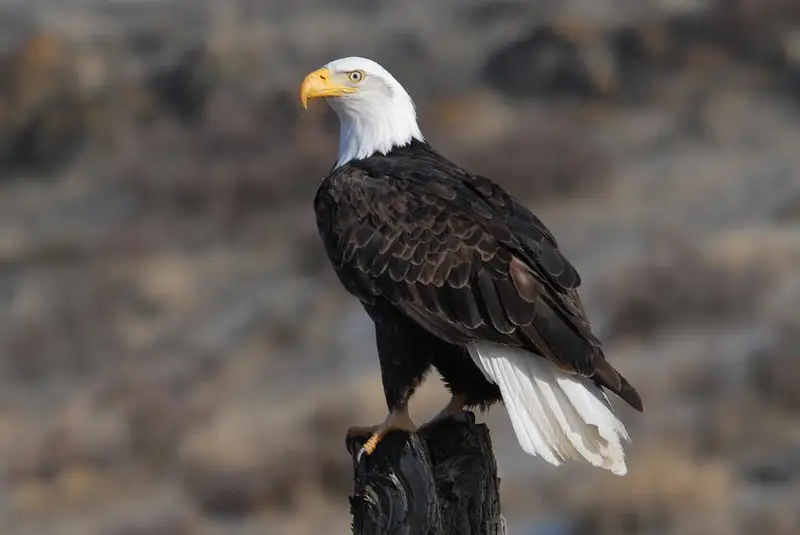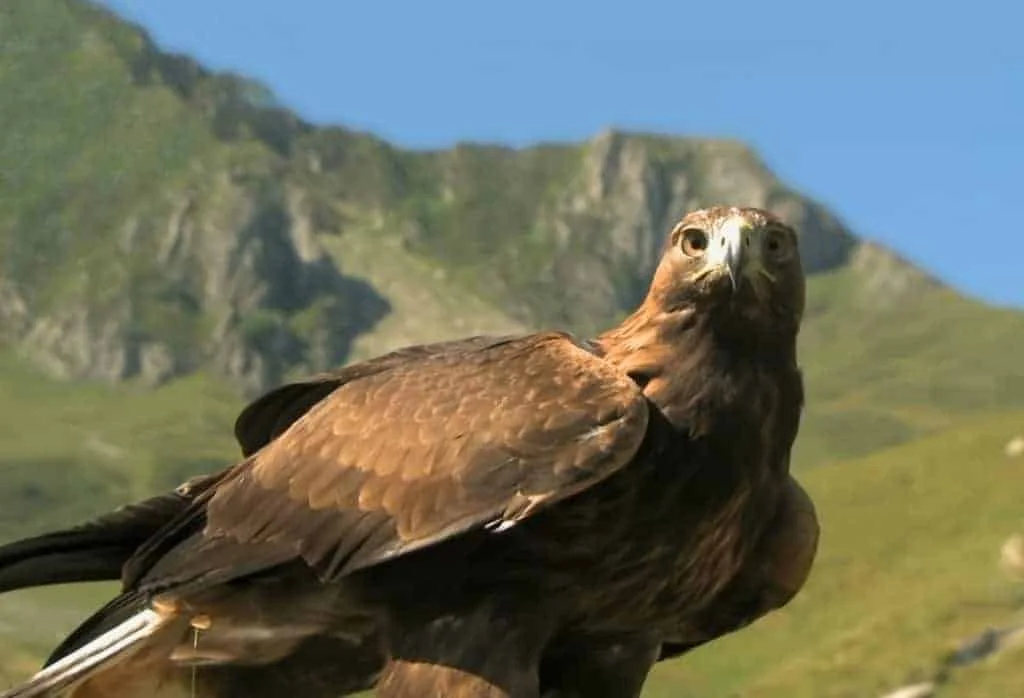In Idaho, it is possible to spot 2 different species of Eagles. These are:
- Bald Eagle
- Golden Eagle
Want to learn more? This book on the Birds of Prey of North America is a fantastic read!
The subtropical southern climate of Georgia is generally too warm for the most prominent North American hunters, who prefer the crisp air near the northwest border.
Fortunately, eagles have made a comeback in the states, largely the result of concentrated efforts in each state to protect their natural habitats.
Georgia took part in efforts by America’s southeastern states to preserve eagles in the mid-90s, and the result is a stabilizing presence of two of the four eagles who visit North America at any given time.
Want to attract birds of prey to your yard? Take a look at our article!
What Eagles can be seen in Idaho?
1. Bald Eagle

America’s mascot is a relatively common sight roaming between to and fro across the Canadian-American border. Bald eagles tend toward the northern part of the state near Montana.
This is likely due to high elevation, but even this cold-adapted raptor will fly to the lowlands to escape the winter chill. The bald eagle’s appearance should be familiar to all bird-watching Americans.
The ‘bald’ of its namesake refers to the whiteness of its head (crown, face, and neck) rather than its color, since bald is an archaic term for a crown that lacks color.
Underneath its regal white head and prominent yellow hooked beak, the bald eagle’s body is a dark brown that may appear gray in some lights that is tinged with lighter browns at the tips.
Its tail is the same white as its head, and its talons match its beak.
While this raptor does have a reputation as a fierce hunter that strikes from on high to snatch marsupials and fish from the ground and water, they are also carrion birds who will feed on the discarded remains of another hunter’s kills.
Like most raptors, bald eagles hunt from high places like mountains and tall pines, striking at lowlands that border forests and wetlands like marshes where fish and rodents are abundant.
Their nests are by far the largest of any bird-of-prey, often several times larger than the bird itself, appearing like an enormous mass of sticks and earth atop a tree, or unseen on the outcroppings of a mountain lookout.
2. Golden Eagle

Also called the Royal Eagle or the King of Birds, this majestic raptor is among the largest of its kind, larger even than the bald eagle in terms of wingspan and length (though not necessarily in bulk).
The ‘golden’ part of its name refers to the light brown plumes across its crown and ‘cape’ (as well as sporadic medium-brown specks throughout), which appear golden compared to a body that is almost exclusively dark brown.
The underside of a golden eagle’s wings is distinctly gray at the tips, which becomes highly visible when it extends its enormous wingspan.
A golden eagle’s beak is as regal as the bald eagle’s, except it is black at the tip and a bit more curved. In Idaho, they are a year-round presence, if uncommon.
Like bald eagles, they like to build large nests on high mountain cliffs that are protected from the elements by boulders. Their treetop nests aren’t as large as eagles, nor as frequent. Golden eagles are also the more ‘honorable’ hunters of the two, eating only what it kills and leaving others to their spoils.
The approach is the same as most raptors, except from perches that are much higher, like the tops of towering pines.
A common feeding ground might be a riparian zone (a wetland that is more wet than land), a riverside plain, or marshlands near the edge of coniferous forests.
Like the bald eagle, their wingspans are so enormous that finding them is often a matter of simply looking up, as they are highly visible from the ground.
Eagles are no longer among the world’s endangered species, thanks to the efforts of animal rights groups and nature-conscious legislators keeping them alive.
With Federal mandates like the Bald and Golden Eagle Protection Act preventing the destruction of the birds and their habitats in states like Idaho, these once-endangered populations have stabilized, and even begun to grow. States like Idaho and Montana should continue to see rising numbers as more eagles migrate from Alaska and northwest Canada.
References
- https://www.audubon.org/field-guide/bird/bald-eagle
- https://www.audubon.org/field-guide/bird/golden-eagle
- https://www.fws.gov/birds/policies-and-regulations/laws-legislations/bald-and-golden-eagle-protection-act.php

About Us
We are avid bird-watchers who recently retired, allowing us more time to travel the world. Fortunately, we have managed to visit numerous countries around Europe, Asia, and America. Watching and photographing birds has been a passion for many years and we are making the most of the extra time on our hands!
